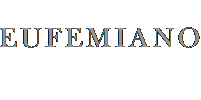| |
Antonio Manuel Campoy, exibition catalogue of the Obra Cultural de la Caja de Ahorros de San Fernando, Seville, 1996
Every painted work of art is, at first –and perhaps also foremost-, paint; immediately thereafter, perhaps at the same time, it is a symbol, that is, a language which relates what is depicted and to what it aspires to be. A painting is, in effect, what Maurice Denis sought: "before a horse or a woman, a surface covered with colours", but a painting without its battle horse and without its naked woman would be self-negation. The negations of painting are, among others, the techniques of "dripping" or "tachisme", simple streams or spots of colour that are, in reality, often not void of a certain decorative appeal.
In Eufemiano's paintings what we first perceive is precisely the paint itself, often sensualised with such fruition and refinement that its unique application could lead us to think that -although highly technical- what stands out in the same is the pictorial matter, the "kitchen", which, said in passing, may come almost to form an aesthetic in its own right, a –materic- autonomy of beauty, as occurs in an exemplary manner with Cossío. However, to stop at this initial perception would be to mutilate the painting as a whole, the complex world it comprises, in which so many elements come together and combine, enough –a sufficient number- so as to give rise to a language, a system of signs that, at the same time, allows for an articulation of symbols. Paintings that appear to be most literal in their representation tend to be, in the end, the most symbolic. Zurbarán, in his still-life depictions of dishes and fruit comes to express –or symbolise- the resistance of earlier ideas and beliefs in respect of the fatuous and excessive language of the baroque, the question as to whether this is due to the extemporaneity of the artist in respect of the XVIIth century not detracting from the outcome. In the works of Chardin, in addition to painting humble domestic scenes, there is a reaction against the excessive magnificence of Versailles. For this reason, although the excellence of Watteau's painting may be equal to that of Chardin, or perhaps even surpass this, it is Chardin that is closest to our time. The subject matter of their work moving from still-life objects to become signs –symbols-.
"To the extent in which a work of art is a sign or representation of the object and not a literal reproduction, it expresses something that was not given to it, something which we perceive from the object and which makes up its structure" says Lévi-Strauss. Nonetheless, in Eufemiano's work real objects are not present to comprise an allegory, or even dreamlike images or literary metaphors. In the works of Maurice Denis there is a sublimation of reality to remove the object from where it is customarily found and, in this manner, make us uneasy. It may be said that Eufemiano, in some sense, participates in a surprise of a surreal nature in that he isolates objects in an astonishing manner and ends up converting them into something more –in much more- than they originally were. Nonetheless, he does this on a very different metaphysical level than the surrealists: perhaps in search of the way to mystical intuition of and with the world.
This process, or procedure, which leads to the thresholds of such intuition (Indian philosophy calls this yoga) is expressed in a plastic manner as a longing to go beyond the painting, albeit through the painting itself, to its metaphysical level. "Man –warns Freud- finds in language a substitute for action". Man is, in this case, the artist. The artist seeks, through symbols, to gain full access to the knowledge of his unconsciousness as a man and as a painting, "that –says Jung- prodigious spiritual inheritance of mankind that is reborn in each individual structure". Unlike the surrealists, this is not achieved through the promiscuous and, in short, unorganised language of dreams, using, on the contrary, objects of a precise and unaltered nature.
This is not, like in hyperrealism, an objective reproduction of reality, inasmuch as it is the painter himself who has at his disposal the objects that he has previously selected or chosen, not as a result of an aesthetic impulse, but rather in accordance with what psychoanalysis refers to as object selection. "In this case –writes Pierre Fedida- the notion of choice is closely related to personal history", and here it would indeed be elucidating to stop to analyse the symbolic objects that are constant to Eufemiano's subject matter, like "a big dream": the mannequin, far removed brother to the homunculus and mandrake; the scallop shell, womb of Venus, jewel of the fortunate journey; the book, flaming sword that will always wound the spirits of the dark, synthesis of the world; the suit of armour, skin of the hero; the basket, subtle reflection of the maternal cloister; and the turtledove, whose voice marks the rhythm of song and of love...
All of this on backgrounds reflecting the richest tones of black. On this undaunted sea of black, constantly alluding to darkness and to the dark passions of the spirit and of the body, the objects that Eufemiano sets out come to be like creatures of the sun, daughters of the light. Daughters of the spirit that is, inextricably, intelligence and goodness: virtue. It is not advisable to go any further because we are about to find ourselves surrounded by ghosts. "He who walks among ghosts –reads a Kabbalah precept- becomes a ghost as well...
|



